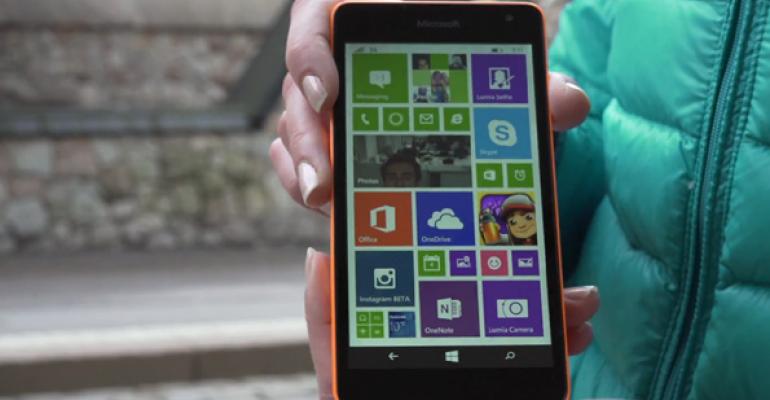If you live in the United States or any other mature market for smart phones, the newly-announced Microsoft Lumia 535 doesn't exactly resonate. But that's by design. Launching first in China, Hong Kong and Bangladesh, this new low-end Lumia is ultra-affordable at about 100 euros and offers an appealing blend of features for "the next billion."
My Microsoft Lumia 535 Preview breaks down the specifications of this new device. Here, I'd like to examine how this new device fits into the already-bloated Lumia lineup and flesh out Microsoft's strategy for this device specifically and for Lumia in general.
First, check out Understanding Nokia's 2014 Lumia Lineup: Pricing. This is a US-centric look at the most recent Lumias, which break down like so from a no-contract pricing perspective:
Lumia 530. $69.99 at Amazon.com.
Lumia 630/5. $129.99 at Amazon.com (now $99.99)
Lumia 730/5. Estimated $299.99 at Verizon in early 2015. (International versions is $299.99 at Expansys.)
Lumia 830. $449.99 at AT&T Wireless. (International unlocked version is $443.99 at Amazon.com.)
Lumia Icon. $499.99 at Verizon, availability is uncertain.
Lumia 1520. $584.99 at Amazon.com.
There's something for everyone, I guess. But if you compare these prices to that of the Lumia 535—which in US dollars would be about $99.99 unlocked—you can see that this handset falls logically enough between the Lumia 530 and 630/635 from a pricing perspective. So the model numbers sort of make sense.
But how does the Lumia 535 match up to these two devices functionally?

The Lumia 530—like the BLU Win HD JR—is a terrible device, with a barely usable screen and super-low-end features, and I can't think of a single instance in which I could recommend this device to anyone. But the Lumia 635, by contrast, is a fine handset. In my Nokia Lumia 635 Review, I explain that this budget handset offers a compelling combination of style and functionality at an appealing price. The Lumia 535, which is less expensive than the 635—though it's unclear if Microsoft will ever sell it in the United States—appears to outclass the 635 in several important ways:
Screen size. The Lumia 535 offers a 5-inch display, which I've often described as the smart phone sweet spot, whereas the 635 has a smaller but very crisp 4.5-inch ClearBlack display. I'll need to see a Lumia 535 before I can render a verdict here, but I think the bigger screen will appeal to many.
Screen resolution. This one is a close call, but the Lumia 535's curious qHD display—960 x 540—beats out the 635's 854 x 480 display. It may be a wash when you consider the relative screen sizes, however.
RAM. The Lumia 535 offers a full 1 GB of RAM, compared to 512 MB on the 635.
Cameras. Whereas both of these handsets have unexceptional 5 MP rear cameras, the 535 has a wide-angle "selfie" camera of sorts on the front that offers a full 5 MP of resolution, albeit with a fixed focus.
Covers. While you can replace the color shell on both devices with other colors, only the Lumia 535 offers a cover option as well. And one of the colors is cyan, which Windows Phone devotees have been clamoring for.

Sensors. This is an area that doesn't get enough attention. While both devices offer an accelerometer and GPS capabilities, of course, only the Lumia 535 has ambient light and proximity sensors, allowing, among other things, automatic screen brightness functionality.
Some features are identical. Both have 8 GB of internal storage and can be expanded with microSD. Neither has a camera button. Both have onscreen Back, Start and Search buttons.
Where the Lumia 535 falls short is the processor, a quad-core Snapdragon 200 running at 1.2 GHz. The Lumia 635 has a better processor, a 1.2 GHz quad-core Snapdragon 400. And the Lumia 635 features SensorCore technologies, which let you use the device like a fitness tracker with compatible software. Kind of a first world problem, if you will.
So once again we see a weird dichotomy where the presumably lower-end phone, in this case, the Lumia 535, has many advantages over a model (the 635) that is higher in the model/price sheet. So the 635 isn't a strict superset of its "lower-end" sibling. This is something I complained about with the Lumia 735 and 830 as well.
But for all the criticism about the lack of a new flagship, it's important to remember that those of us in the United States, Western Europe and elsewhere who are clamoring for such devices do not constitute a sizable market. Instead, Microsoft is following the money, and the biggest potential audience. And that's to be found in the low-end of the market.
Here, I think, the Lumia 535 does provide a tremendous value. And like the HP Stream 11 laptop, the HP Stream 7 mini-tablet (presumably, mine is on the way), or any number of other low-cost but high quality Windows devices, it hits a sweet spot of its own making. I think this is what Microsoft means when it says "making the market" for Windows Phone. That it needs to establish a place where it can be successful, both geographically, and from a price/value perspective.
The Lumia 535 certainly accomplishes that. Yes, I'd like the Lumia lineup to make a bit more sense in that it's not always clear what features end up where and why. And yes, God yes, I'd love to see a set of true Lumia flagships emerge too. But for this device, I think it's clear we need to just agree it's for us and move on. They had to start somewhere.





